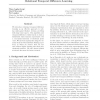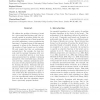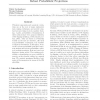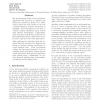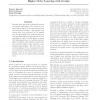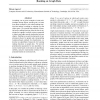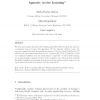ICML
2006
IEEE
15 years 16 days ago
2006
IEEE
A family of probabilistic time series models is developed to analyze the time evolution of topics in large document collections. The approach is to use state space models on the n...
ICML
2006
IEEE
15 years 16 days ago
2006
IEEE
We introduce relational temporal difference learning as an effective approach to solving multi-agent Markov decision problems with large state spaces. Our algorithm uses temporal ...
ICML
2006
IEEE
15 years 16 days ago
2006
IEEE
We address the problem of learning a kernel for a given supervised learning task. Our approach consists in searching within the convex hull of a prescribed set of basic kernels fo...
ICML
2006
IEEE
15 years 16 days ago
2006
IEEE
Principal components and canonical correlations are at the root of many exploratory data mining techniques and provide standard pre-processing tools in machine learning. Lately, p...
ICML
2006
IEEE
15 years 16 days ago
2006
IEEE
In recent years, there has been a proliferation of theoretical graph models, e.g., preferential attachment and small-world models, motivated by real-world graphs such as the Inter...
ICML
2006
IEEE
15 years 16 days ago
2006
IEEE
ICML
2006
IEEE
15 years 16 days ago
2006
IEEE
We experimentally study on-line investment algorithms first proposed by Agarwal and Hazan and extended by Hazan et al. which achieve almost the same wealth as the best constant-re...
ICML
2006
IEEE
15 years 16 days ago
2006
IEEE
Recently there has been considerable interest in learning with higher order relations (i.e., three-way or higher) in the unsupervised and semi-supervised settings. Hypergraphs and...
ICML
2006
IEEE
15 years 16 days ago
2006
IEEE
In ranking, one is given examples of order relationships among objects, and the goal is to learn from these examples a real-valued ranking function that induces a ranking or order...
ICML
2006
IEEE
15 years 16 days ago
2006
IEEE
We state and analyze the first active learning algorithm which works in the presence of arbitrary forms of noise. The algorithm, A2 (for Agnostic Active), relies only upon the ass...

